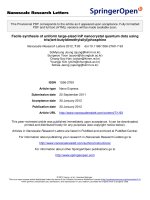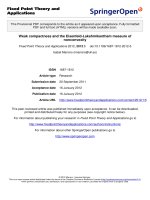Báo cáo toán học: " Further results of the estimate of growth of entire solutions of some classes of algebraic differential equations" docx
Bạn đang xem bản rút gọn của tài liệu. Xem và tải ngay bản đầy đủ của tài liệu tại đây (258.73 KB, 18 trang )
This Provisional PDF corresponds to the article as it appeared upon acceptance. Fully formatted
PDF and full text (HTML) versions will be made available soon.
Further results of the estimate of growth of entire solutions of some classes of
algebraic differential equations
Advances in Difference Equations 2012, 2012:6 doi:10.1186/1687-1847-2012-6
Oi Jiaming ()
Li Yezhou ()
Yuan Wenjun ()
ISSN 1687-1847
Article type Research
Submission date 2 July 2011
Acceptance date 1 February 2012
Publication date 1 February 2012
Article URL />This peer-reviewed article was published immediately upon acceptance. It can be downloaded,
printed and distributed freely for any purposes (see copyright notice below).
For information about publishing your research in Advances in Difference Equations go to
/>For information about other SpringerOpen publications go to
Advances in Difference
Equations
© 2012 Jiaming et al. ; licensee Springer.
This is an open access article distributed under the terms of the Creative Commons Attribution License ( />which permits unrestricted use, distribution, and reproduction in any medium, provided the original work is properly cited.
Further results of the estimate of growth
of entire solutions of some classes of
algebraic differential equations
Qi Jianming
1,3
, Li Yezhou
2
and Yuan Wenjun
∗3
1
Department of Mathematics and Physics, Shanghai Dianji
University, Shanghai 200240, People’s Republic of China
2
School of Science, Beijing University of Posts and
Telecommunications, Beijing 100876, People’s Republic of China
3
School of Mathematics and Information Science, Guangzhou
University, Guangzhou 510006, People’s Republic of China
∗
Corresponding author: ;
Email addresses:
QJ:
LY:
2
Abstract
In this article, by means of the normal family theory, we estimate the
growth order of entire solutions of some algebraic differential equations
and improve the related results of Bergweiler, Barsegian, and others.
We also estimate the growth order of entire solutions of a type system
of a special algebraic differential equations. We give some examples to
show that our results are sharp in special cases.
Mathematica Subject Classification (2000): Primary 34A20; Secondary
30D35.
Keywords: Meromorphic functions; Nevanlinna theory; Normal family;
Growth order; Algebraic differential equation.
1. Introduction and main results
Let f (z) be a meromorphic function in the complex plane. We use the standard
notation of the Nevanlinna theory of meromorphic functions and denotes the order
of f(z) by λ(f) (see [1–3]).
Let C be the whole complex domain. Let D be a domain in C and F be a
family of meromorphic functions defined in D. F is said to be normal in D, in
the sense of Montel, if each sequence {f
n
} ⊂ F has a subsequence {f
n
j
} which
converse spherically locally uniformly in D, to a meromorphic function or ∞ (see
[1]).
3
In general, it is not easy to have an estimate on the growth of an entire or
meromorphic solution of a nonlinear algebraic differential equation of the form
P (z, w, w
, . . . , w
(k)
) = 0, (1.1)
where P is a polynomial in each of its variables.
A general result was obtained by Gol
dberg [4]. He obtained
Theorem 1.1. All meromorphic solutions of algebraic differential equation (1.1)
have finite order of growth, when k = 1.
For a half century, Bank and Kaufman [5] and Barsegian [6] gave some ex-
tensions or different proofs, but the results have not changed. Barsegian [7] and
Bergweiler [8] have extended Gol
dberg’s result to certain algebraic differential
equations of higher order. In 2009, Yuan et al. [9], improved their results and gave
a general estimate of order of w(z), which depends on the degrees of coefficients of
differential polynomial for w(z). In order to state these results, we must introduce
some notations: m ∈ N = {1, 2, 3, . . .}, r
j
∈ N
0
= N ∪ {0} for j = 1, 2, . . . , m, and
put r = (r
1
, r
2
, . . . , r
m
). Define M
r
[w](z) by
M
r
[w](z) := [w
(z)]
r
1
[w
(z)]
r
2
· · · [w
(m)
(z)]
r
m
,
4
with the convention that M
{0}
[w] = 1. We call p(r) := r
1
+ 2r
2
+ · · · + mr
m
the
weight of M
r
[w]. A differential polynomial P [w] is an expression of the form
P [w](z) :=
r∈I
a
r
(z, w(z))M
r
[w] (1.2)
where the a
r
are rational in two variables and I is a finite index set. The weight
deg P [w] of P [w] is given by deg P [w] := max
r∈I
p(r). deg
z,∞
a
r
denotes the degree
at infinity in variable z concerning a
r
(z, w). deg
z,∞
a := max
r∈I
max{deg
z,∞
a
r
, 0}.
Theorem 1.2. [9] Let w(z) be a meromorphic function in the complex plane,
n ∈ N, P [w] be a polynomial with the form (1.2) n > deg P [w]. If w(z) satisfies
the differential equation [w
(z)]
n
= P [w], then the growth order λ := λ(w) of w(z)
satisfies
λ ≤ 2 +
2 deg
z,∞
a
n − deg P [w]
.
Recently, Qi et al. [10] further improved Theorem 1.2 as below.
Theorem 1.3. Let w(z) be a meromorphic function in the complex plane and all
zeros of w(z) have multiplicity at least k ( k ∈ N), P [w] b e a polynomial with the
form (1.2) and nkq > deg P [w] (n ∈ N). If w(z) satisfies the differential equation
[Q(w
(k)
(z))]
n
= P [w], then the growth order λ := λ(w) of w(z) satisfies
λ ≤ 2 +
2 deg
z,∞
a
nqk − deg P [w]
,
where Q(z) is a polynomial with degree q.
5
In this article, we first give a small upper bound for entire solutions.
Theorem 1.4. Let w(z) be an entire function in the complex plane and all zeros
of w(z) have multiplicity at least k (k ∈ N), P [w] be a polynomial with the
form (1.2) and nkq > deg P [w] (n ∈ N). If w(z) satisfies the differential equation
[Q(w
(k)
(z))]
n
= P [w], then the growth order λ := λ(w) of w(z) satisfies
λ ≤ 1 +
deg
z,∞
a
nqk − deg P [w]
,
where Q(z) is a polynomial with degree q.
Example 1 For n = 2, entire function w(z) = e
z
2
satisfies the following algebraic
differential equation
(w
)
2
= 4w
2
+ 16z
2
w
2
+ 8z
3
w
w ,
we know deg
z,∞
a = 3, deg P[w] = 2, So λ = 2 ≤ 1 +
3
2×2−1
= 2. This example
illustrates that Theorem 1.4 is an extending result of Theorem 1.3 and our result
is sharp in the special cases.
By Theorem 1.4, we immediately have the following corollaries.
Corollary 1.5. Let w(z) be an entire function in the complex plane and all zeros
of w(z) have multiplicity at least k (k ∈ N), P [w] be a differential polynomial
6
with constant coefficients in variable w or deg
z,∞
a
t
≤ 0(t ∈ I) in the (1.2) and
nkq > deg P [w] (n ∈ N). If w(z) satisfies the differential equation [Q(w
(k)
(z))]
n
=
P [w], then the growth order λ := λ(w) of w(z) satisfies λ ≤ 1, where Q(z) is a
polynomial with degree q.
Corollary 1.6. Let w(z) be an entire function in the complex plane and all zeros
of w(z) have multiplicity at least k (k ∈ N), P [w] be a polynomial with the
form (1.2) and nk > deg P [w] (n ∈ N). If w(z) satisfies the differential equation
[H(w(z))]
n
= P [w], then the growth order λ := λ(w) of w(z) satisfies
λ ≤ 1 +
deg
z,∞
a
nk − deg P [w]
,
where H(w(z)) = w
(k)
(z) + b
k−1
w
(k−1)
(z) + b
k−2
w
(k−2)
(z) + · · · + b
1
w(z) + b
0
and
b
k−1
, . . . , b
0
are constants.
In 2009, Gu et al. [11] investigated the growth order of solutions of a type
systems of algebraic differential equations of the form
(w
2
)
m
1
= a(z)w
(n)
1
,
(w
(n)
1
)
m
2
= P[w
2
]
(1.3)
where m
1
, m
2
are the non-negative integer, a(z) is a polynomial, P[w
2
] is defined
by (1.2).
They obtained the following result.
Theorem 1.7. Let w = (w
1
, w
2
) be the meromorphic solution vector of a type
systems of algebraic differential equations of the form (1.3), if m
1
m
2
> deg P (w
2
),
7
then the growth orders λ(w
i
) of w
i
(z) for i = 1, 2 satisfy
λ(w
1
) = λ(w
2
) ≤ 2 +
2(ν + deg
z,∞
a)
m
1
m
2
− deg P (w
2
)
where ν = deg(a(z))
m
2
.
Qi et al. [10] also consider the similar result to Theorem 1.7 for the systems
of the algebraic differential equations
(Q(w
(k)
2
(z)))
m
1
= a(z)w
(n)
1
(w
(n)
1
)
m
2
= P(w
2
),
(1.4)
where Q(z) is a polynomial with degree q.
They obtained the following result.
Theorem 1.8. Let w = (w
1
, w
2
) be a meromorphic solution of a type systems of
algebraic differential equations of the form (1.4), if m
1
m
2
qk > deg P(w
2
), and all
zeros of w
2
(z) have multiplicity at least k (k ∈ N), then the growth orders λ(w
i
)
of w
i
(z) for i = 1, 2 satisfy
λ(w
1
) = λ(w
2
) ≤ 2 +
2(ν + deg
z,∞
a)
m
1
m
2
qk − deg P (w
2
)
,
where ν = deg(a(z))
m
2
.
Similarly, we have a small upper bounded estimate for entire solutions below.
8
Theorem 1.9. Let w = (w
1
, w
2
) be an entire solution of a type systems of algebraic
differential equations of the form (1.4), if m
1
m
2
qk > deg P (w
2
), and all zeros of
w
2
(z) have multiplicity at least k (k ∈ N), then the growth orders λ(w
i
) of w
i
(z)
for i = 1, 2 satisfy
λ(w
1
) = λ(w
2
) ≤ 1 +
ν + deg
z,∞
a
m
1
m
2
qk − deg P (w
2
)
,
where ν = deg(a(z))
m
2
.
By Theorem 1.9, we immediately obtain a corollary below.
Corollary 1.10. Let w = (w
1
, w
2
) be an entire solution of a type systems of alge-
braic differential equations of the form
(H(w
2
))
m
1
= a(z)w
(n)
1
(w
(n)
1
)
m
2
= P(w
2
),
(1.5)
where H(w(z)) = w
(k)
(z)+b
k−1
w
(k−1)
(z)+b
k−2
w
(k−2)
(z)+· · ·+b
0
and b
k−1
, . . . , b
0
are constants. If m
1
m
2
qk > deg P (w
2
), and all zeros of w
2
(z) have multiplicity at
least k (k ∈ N), then the growth orders λ(w
i
) of w
i
(z) for i = 1, 2 satisfy
λ(w
1
) = λ(w
2
) ≤ 1 +
ν + deg
z,∞
a
m
1
m
2
qk − deg P (w
2
)
,
where ν = deg(a(z))
m
2
.
9
Example 2 Set w
1
(z) = e
z
+ c, w
2
(z) = e
z
satisfy a type systems of algebraic
differential equations of the form
(w
(k)
2
) = w
(n)
1
(w
(n)
1
)
5
= (w
2
)
3
(w
2
)
2
,
(1.6)
where c is a constant, m
1
= 1, m
2
= 5, ν = 0, deg
z,∞
a = 0, and deg P(w
2
) = 2.
The (1.6) satisfies the m
1
m
2
= 5 > 2 = deg P (w
2
). So λ(w
1
) = λ(w
2
) = 1 ≤ 1.
So the conclusion of Theorem 1.9, Corollary 1.10 may occur and our results are
sharp in the special cases.
2. Preliminary lemmas
In order to prove our result, we need the following lemmas. The first one extends
a famous result by Zalcman [12] concerning normal families. Zalcman’s lemma is a
very important tool in the study of normal families. It has also undergone various
extensions and improvements. The following is one up-to-date local version, which
is due to Pang and Zaclman [13].
Lemma 2.1 [13,14] Let F be a family of meromorphic (analytic) functions in the
unit disc with the property that for each f ∈ F, all zeros of multiplicity at least
k. Suppose that there exists a number A ≥ 1 such that |f
(k)
(z)| ≤ A whenever
f ∈ F and f = 0. If F is not normal in ∆, then for 0 ≤ α ≤ k, there exist
1. a number r ∈ (0, 1);
2. a sequence of complex numbers z
n
, |z
n
| < r;
10
3. a sequence of functions f
n
∈ F;
4. a sequence of positive numbers ρ
n
→ 0
+
;
such that g
n
(ξ) = ρ
−α
n
f
n
(z
n
+ ρ
n
ξ) converges locally uniformly (with respect
to the spherical metric) to a non-constant meromorphic (entire) function g(ξ) on C,
and moreover, the zeros of g(ξ) are of multiplicity at least k, g
(ξ) ≤ g
(0) = kA+1.
In particular, g has order at most 2. In particular, we may choose w
n
and ρ
n
, such
that
ρ
n
≤
2
[f
n
(w
n
)]
1
1+|α|
, f
n
(w
n
) ≥ f
n
(0).
Here, as usual, g
(ξ) =
|g
(ξ)|
1+|g(ξ)|
2
is the spherical derivative. For 0 ≤ α < k, the
hypothesis on f
(k)
(z) can be dropped, and kA + 1 can be replaced by an arbitrary
positive constant.
Lemma 2.2 [15] Let f (z) be holomorphic in whole complex plane with growth
order λ := λ(f ) > 1, then for each 0 < µ < λ − 1, there exists a sequence a
n
→ ∞,
such that
lim
n→∞
f
(a
n
)
|a
n
|
µ
= +∞. (2.1)
11
3. Proof of the results
Proof of Theorem 1.4 Suppose that the conclusion of theorem is not true, then
there exists an entire solution w(z) satisfies the equation [Q(w(z))]
n
= P [w]. such
that
λ > 1 +
deg
z,∞
a
nqk − deg P [w]
. (3.1)
By Lemma 2.2 we know that for each 0 < ρ < λ − 1, there exists a sequence of
points a
m
→ ∞(m → ∞), such that (2.1) is right. This implies that the family
{w
m
(z) := w(a
m
+ z)}
m∈N
is not normal at z = 0. By Lemma 2.1, there exist
sequences {b
m
} and {ρ
m
} such that
|a
m
− b
m
| < 1, ρ
m
→ 0, (3.2)
and g
m
(ζ) := w
m
(b
m
− a
m
+ ρ
m
ζ) = w(b
m
+ ρ
m
ζ) converges locally uniformly to
a nonconstant entire function g(ζ), which order is at most 2, all zeros of g(ζ) have
multiplicity at least k . In particular, we may choose b
m
and ρ
m
, such that
ρ
m
≤
2
w
(b
m
)
, w
(b
m
) ≥ w
(a
m
). (3.3)
According to (2.1) and (3.1)–(3.3), we can get the following conclusion:
For any fixed constant 0 ≤ ρ < λ − 1, we have
lim
m→∞
b
ρ
m
ρ
m
= 0. (3.4)
12
In the differential equation [Q(w
(k)
(z))]
n
= P [w(z)], we now replace z by
b
m
+ ρ
m
ζ. Assuming that P [w] has the form (1.2). Then we obtain
(Q(w
(k)
(b
m
+ ρ
m
ζ)))
n
=
r∈I
a
r
(b
m
+ ρ
m
ζ, g
m
(ζ))ρ
−p(r)
m
M
r
[g
m
](ζ),
where
Q(w
(k)
(b
m
+ ρ
m
ζ)) = ρ
−qk
m
[(g
(k)
m
)
q
(ζ) + ρ
k
m
a
q − 1
(g
(k)
m
)
q −1
(ζ)+
+ · · · + ρ
(q−1)k
m
a
1
g
(k)
m
(ζ) + ρ
q k
m
a
0
].
Hence we deduce that
ρ
−nqk
m
[(g
(k)
m
)
q
(ζ) + ρ
k
m
a
q − 1
(g
(k)
m
)
q −1
(ζ) + · · · + ρ
q k
m
a
0
]
n
=
r∈I
a
r
(b
m
+ ρ
m
ζ, g
m
(ζ))ρ
−p(r)
m
M
r
[g
m
](ζ).
Therefore
[(g
(k)
m
)
q
(ζ)+ ρ
k
m
a
q − 1
(g
(k)
m
)
q −1
(ζ) + · · · + ρ
qk
m
a
0
]
n
=
r∈I
a
r
(b
m
+ρ
m
ζ,g
m
(ζ))
b
deg
z,∞
a
r
m
[b
deg
z,∞
a
r
nqk−p(r)
m
ρ
m
]
nqk−p(r)
M
r
[g
m
](ζ).
(3.5)
Because 0 ≤ ρ =
deg
z,∞
a
r
nqk−p(r)
≤
deg
z,∞
a
nqk−deg P [w]
< λ − 1, p(r) < nqk, for every fixed
ζ ∈ C, if ζ is not the zero of g(ζ), by (3.4) then we can get g
(k)
(ζ) = 0 from (3.5).
By the all zeros of g(ζ) have multiplicity at least k, this is a contradiction.
The proof of Theorem 1.4 is complete.
13
Proof of Theorem 1.9 By the first equation of the systems of algebraic differential
equations (1.4), we know
w
(n)
1
=
(Q(w
(k)
2
(z)))
m
1
a(z)
.
Therefore we have
λ(w
1
) = λ(w
2
).
If w
2
is a rational function, then w
1
must be a rational function, so that the
conclusion of Theorem 2 is right. If w
2
is a transcendental meromorphic function,
by the systems of algebraic differential equations (1.3), then we have
(Q(w
(k)
2
))
m
1
m
2
= (a(z))
m
2
P (w
2
). (3.6)
Suppose that the conclusion of Theorem 2 is not true, then there exists an
entire vector w(z) = (w
1
(z), w
2
(z)) which satisfies the system of equations (1.4)
such that
λ := λ(w
2
) > 1 +
ν + deg
z,∞
a
m
1
m
2
qk − deg P (w
2
)
, . (3.7)
By Lemma 2.2 we know that for each 0 < ρ < λ − 1, there exists a sequence of
points a
m
→ ∞(m → ∞), such that (2.1) is right. This implies that the family
{w
m
(z) := w(a
m
+ z)}
m∈N
is not normal at z = 0. By Lemma 2.1, there exist
sequences {b
m
} and {ρ
m
} such that
|a
m
− b
m
| < 1, ρ
m
→ 0, (3.8)
14
and g
m
(ζ) := w
2,m
(b
m
− a
m
+ ρ
m
ζ) = w
2
(b
m
+ ρ
m
ζ) converges locally uniformly
to a nonconstant entire function g(ζ), which order is at most 2, all zeros of g(ζ)
have multiplicity at least k . In particular, we may choose b
m
and ρ
m
, such that
ρ
m
≤
2
w
2
(b
m
)
, w
2
(b
m
) ≥ w
2
(a
m
). (3.9)
According to (3.6) and (3.7)–(3.9), we can get the following conclusion:
For any fixed constant 0 ≤ ρ < λ − 1, we have
lim
m→∞
b
ρ
m
ρ
m
= 0. (3.10)
In the differential equation (3.6) we now replace z by b
m
+ ρ
m
ζ, then we
obtain
(Q(w
(k)
2
(b
m
+ ρ
m
ζ)))
m
1
m
2
=
r∈I
a(b
m
+ ρ
m
ζ)
m
2
a
r
(b
m
+ ρ
m
ζ, g
m
(ζ))ρ
−p(r)
m
M
r
[g
m
](ζ),
where
Q(w
(k)
2
(b
m
+ ρ
m
ζ)) = ρ
−qk
m
[(g
(k)
m
)
q
(ζ) + ρ
k
m
a
q − 1
(g
(k)
m
)
q −1
(ζ)+
+ · · · + ρ
q k
m
a
1
g
(k)
m
(ζ)].
Namely
[(g
(k)
m
)
q
(ζ)+ρ
k
m
a
q − 1
(g
(k)
m
)
q − 1
(ζ)+· · ·+ρ
qk
m
a
1
g
(k)
m
(ζ)]
m
1
m
2
=
r∈I
a(b
m
+ ρ
m
ζ)
m
2
a
r
(b
m
+ ρ
m
ζ, g
m
(ζ))
b
a+deg
z,∞
a
r
m
{b
a+deg
z,∞
a
r
m
1
m
2
qk−p(r)
m
ρ
m
}
m
1
m
2
qk−p(r)
M
r
[g
m
](ζ).
(3.11)
15
For every fixed ζ ∈ C, if ζ is not zero of g(ζ), for m → ∞ and 0 ≤ ρ =
a+deg
z,∞
a
r
m
1
m
2
q k−p(r)
≤
a+deg
z,∞
a
m
1
m
2
q k−deg P (w
2
)
< λ − 1 then we have (g
(k)
)
m
1
m
2
= 0, which
contradicts with all zeros of g(ζ) have multiplicity at least k. So λ(w
2
) ≤ 1 +
a+deg
z,∞
a
m
1
m
2
q k−deg P (w
2
)
.
The proof of Theorem 1.9 is complete.
Competing interests
The authors declare that they have no competing interests.
Authors’ Contributions
JQ carried out the main part of this manuscript. YL and WY participated dis-
cussion and corrected the main theorem. All authors read and approved the final
manuscript.
Acknowledgments
The authors wish to thank the referees and editor for their very helpful comments
and useful suggestions. This study was partially supported by Leading Academic
Discipline Project ( 10XKJ01 ) and Key Development Project ( 12C102 ) of Shang-
hai Dianji University, also was partially supported by NSFC of China ( 11101048
and 10771220 ), Doctorial Point Fund of National Education Ministry of China (
200810780002 ).
(in press, in Chinese)
16
References
[1] Hayman, WK: Meromorphic Functions. Clarendon Press, Oxford (1964)
[2] He, YZ, Xiao, XZ: Algebroid Functions and Ordinary Differential Equations. Science
Press, Beijing (1988) (in Chinese)
[3] Laine, I: Nevanlinna Theory and Complex Differential Equations. de Gruyter, Berlin
(1993)
[4] Gol
db erg, AA: On single-valued solutions of algebraic differential equations. Ukrain
Mat Zh. 8, 254–261 (1956)
[5] Bank, S, Kaufman, R: On meromorphic solutions of first-order differential equations.
Comment. Math., Helv. 51, 289–299 (1976)
[6] Barsegian, G: Estimates of derivatives of meromorphic functions on sets of α-points.
J. Lond. Math. Soc. 34(2), 534–540 (1986)
[7] Barsegian, G: On a method of study of algebraic differential equations. Bull. Hong
Kong Math. Soc. 2(1), 159–164 (1998)
[8] Bergweiler, W: On a theorem of Gol’dberg concerning meromorphic solutions of
algebraic differential equations. Complex Var. 37, 93–96 (1998)
[9] Yuan, WJ, Xiao, B, Zhang, JJ: The general result of Gol’dberg’s theorem concerning
the growth of meromorphic solutions of algebraic differential equations. Comput.
Math. Appl. 58, 1788–1791 (2009)
[10] Qi, JM, Li, YZ, Yuan, WJ: Further results of Gol
db erg’s theorem concerning the
growth of meromorphic solutions of algebraic differential equations. Acta Math. Sci.
17
[11] Gu, RM, Ding, JJ, Yuan, WJ: On the estimate of growth order of solutions of a
class of systems of algebraic differential equations with higher orders. J. Zhanjiang
Normal Univ. (in Chinese) 30(6), 39–43 (2009)
[12] Zalcman, L: A heuristic principle in complex function theory. Am. Math. Monthly
82, 813–817 (1975)
[13] Pang, XC, Zalcman L: Normal families and shared values. Bull. Lond. Math. Soc.
32, 325–331 (2000)
[14] Zalcman, L: Normal families new perspectives. Bull. Am. Math. Soc. 35, 215–230
(1998)
[15] Gu, RM, Li, ZR, Yuan, WJ: The growth of entire solutions of some algebraic differen-
tial equations. Georgian Math. J. 18(3), 489–495 (2011). doi:10.1515/GMJ.2011-003









